
Berlin’s Fernsehturm (TV Tower), seemingly visible from everywhere in the centre of the city.
A really busy week, which culminated in a trip to Berlin with my two brothers and my dad as our gift to him in celebration of his 70th birthday. After last year’s big family holiday, we figured that the best present would be to spend some more quality time together. It was wonderful, but I am exhausted.
Friday’s alarm went off just after 5am as I had a taxi picking me up an hour later. The week had been hectic, and I was already worn out before we got going. We’d collaborated on our schedule using a shared Apple Note; all that we had planned for the first day was dinner in the evening. It was great to land at the lounge and get some breakfast.

An early morning birthday toast at Heathrow
Berlin has so much to offer. It’s a city with an incredible history, but like London it blends this with modern architecture. Our hotel was situated next to the sparkling glass-clad Central Station, a short hop from the Bundeskanzleramt (German Chancellery) and Reichstag buildings. The accommodation was great — a very modern, classy, business-focused building with a decent bar and an excellent buffet.
After checking ourselves in, we asked the front desk for a recommendation for somewhere to grab a beer and a light bite to eat. They pointed us towards Lindenbräu in Potsdamer Platz. It’s a strange place to go for beer; the vibe was more ‘Saturday afternoon shopping experience’ than ‘traditional German bierkeller’, but we were too tired to start traipsing around the city. It was here that we met Jürgen, our dad’s doppelgänger. Over the course of several beers we established that both men were the same age, both semi-retired and working in order to keep themselves active and busy. Jürgen kept everyone’s glasses full and made us feel right at home.

Doppelgängers
In the evening we took a taxi across to Zur Letzten Instanz, ‘Berlin’s oldest restaurant’, which recently celebrated its 400th birthday. The food was excellent. The meat-eaters tucked into their first taste of traditional pork knuckle and I sampled the mashed potato, eggs and mustard.
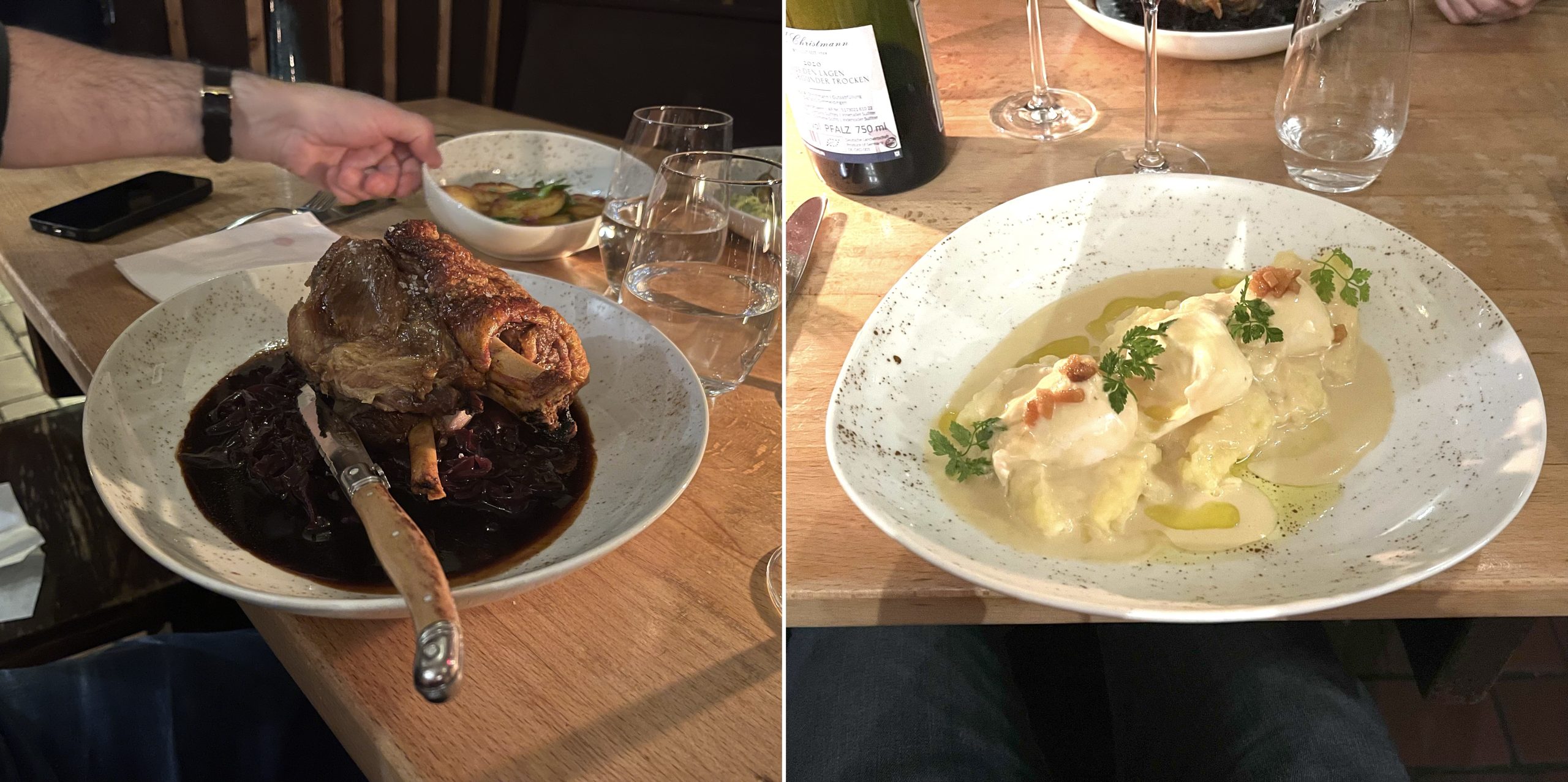
Pork knuckle, mashed potato, eggs and mustard.
The next morning we were up bright and early to take advantage of the hotel’s excellent buffet before heading out to meet our guide for a World War 2-themed walking tour. It was a quick couple of train stops to Hackescher Markt, the meeting place for Original Berlin Walks. James, our tour guide, was excellent. Half of the tour was close to the meeting point and the other was over towards the central government buildings.
We started at the Alter Jüdischer Friedhof (Old Jewish Cemetery). James explained that back in the 1700s, Jews were invited to come and live in Berlin. This cemetery was established around this time. Outside the cemetery there is a haunting sculpture called Jewish Victims of Fascism by Will Lammert.

Jewish Victims of Fascism by Will Lammert
Our next stop was The Missing House, the site of a residence that was bombed during World War 2. Artist Christian Boltanski installed plaques on the houses either side of the gap to show who lived there at the time of the bombing.

The Missing House
As we walked, we noticed the ‘stumbling stones’ that are placed in the pavement. This is a project of remembrance for victims of the Nazi extermination or persecution. The stones are placed at the last place that they lived or worked before they were taken. Each one is tiny story. Given how difficult it is to get one’s head around the magnitude of the violence and atrocities, I love how this project gives a slice of access into individual narratives.

Stumbling stones
A nearby park is home to a metal sculpture called The Deserted Room. It depicts a fragment of the scene of a room that has been deserted by its occupants who have been forcibly taken away. Our guide observed how the sculpture isn’t very prescriptive in terms of what it represents and how you should feel when you look at it; there is lots of room for interpretation and projection.

The Deserted Room
Our next stop was the New Synagogue, a surprisingly ostentatious building in central Berlin. Our guide relayed how the building was saved from arsonists during the November Pogrom on 9 November 1938 by Otto Bellgardt, a local police officer who was on duty that night. He ran into the building clutching some random papers from his desk which he claimed were orders to preserve it as a historical landmark, and to avoid the fire spreading to the post office a few buildings away. The vandals didn’t bother to read the documents and left, allowing the fire to be put out. Nobody understands why he did this.

New Synagogue, Berlin
We walked by the Berlin Anhalter Bahnhof, the now ruined remains of a railway station that was used for thousands of deportations.

The ruined remains of the Berlin Anhalter Bahnhof
A few minutes walk brought us to Wilhelmstrasse, site of a striking memorial to Georg Elser. Elser had tried to assassinate Hitler in Munich in 1939 by putting a bomb under a stage where he was due to speak. Unfortunately, the weather was poor so Hitler decided to leave the venue early. His lucky escape was interpreted by Hitler as a sign that he was destined to continue towards his goals. Elser was kept alive until 1945 in anticipation of using him for propaganda in the form of a show trial. He was murdered four weeks before the end of the war in Europe.

Memorial to Georg Elser on Wilhelmstrasse
We next came to the site of Hitler’s bunker. Fittingly, no traces of the bunker remain and it is now an unremarkable car park.

Site of the Führerbunker
Our next stop was the massive Memorial to the Murdered Jews of Europe. It’s another artistic work that is not prescriptive — the 2,711 concrete blocks that make up the site are open to interpretation, in both their form and number. At the edges of the installation the blocks are relatively short; as you move towards the center of the matrix, along the uneven paths, they begin to tower over you. Towards the Tiergarten some trees appear, blending the memorial with its surroundings. It’s a moving and affecting place.
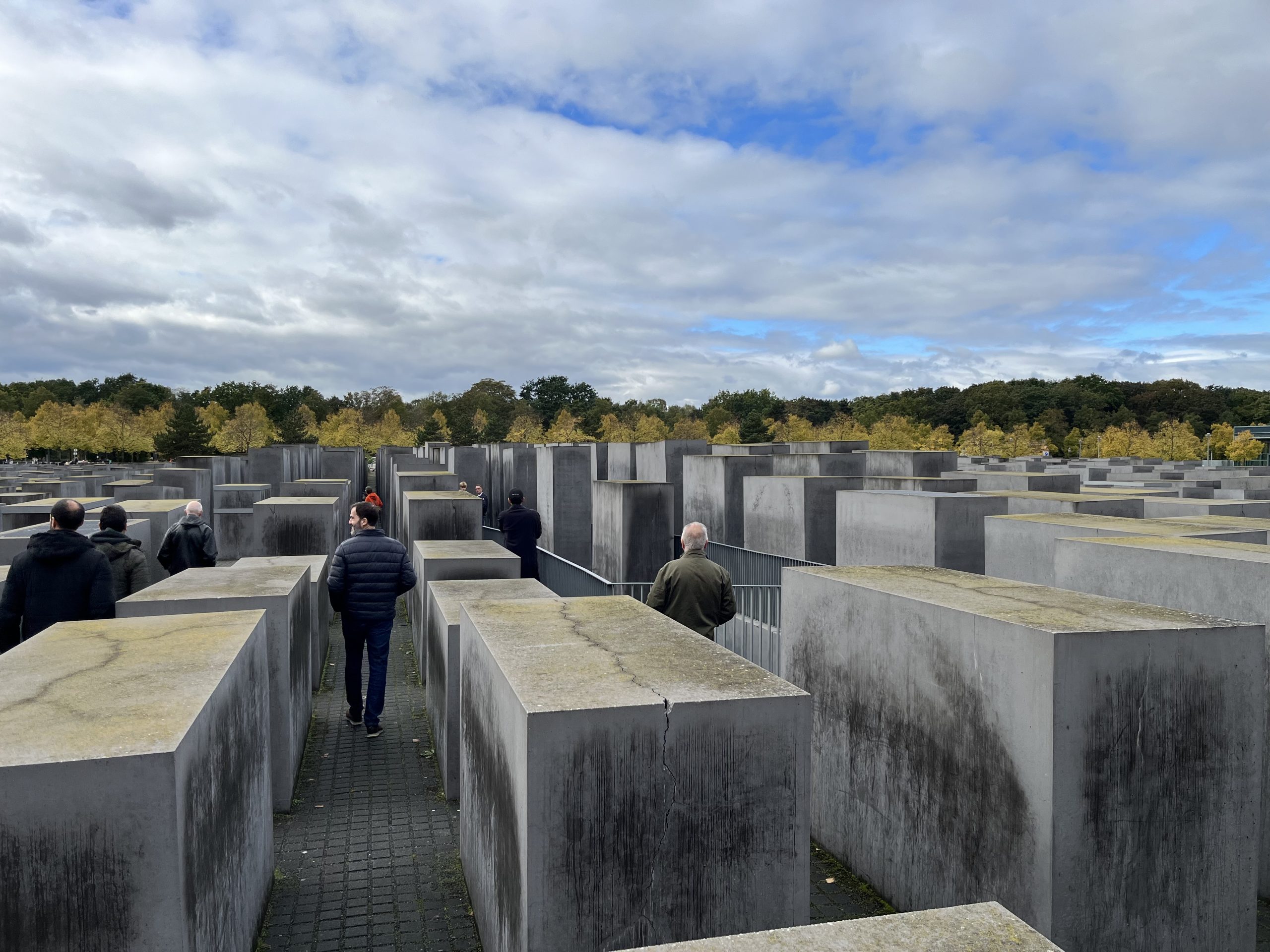
At the edge of the Memorial to the Murdered Jews of Europe

Towards the centre of the At the edge of the Memorial to the Murdered Jews of Europe
Later in the day, once our tour had finished, we came back to visit the Information Centre located under the memorial. It is the opposite of the sculpture in that it contains lots of information about the Holocaust, with photographs, letters and other exhibits from the period. In ‘The Room of Names’, every minute the name of a victim is shown on the walls as an audio biography is read out. With the amount of information currently held by the Centre, cycling through the names takes a staggering six years, seven months and 27 days.
We had a couple of stops left on our tour. Wandering past the Brandenburg Gate, crossing over a line of stones in the road that denoted the previous location of the Berlin Wall, we found ourselves in front of the Soviet War Memorial. Two T-34 tanks are located in front of the memorial, one on each side; apparently they are meant to be the first two Soviet tanks to enter Berlin in 1945. The site is located in what was the British sector of the city, but Soviet guards were allowed to stand watch on the site. The city is such a mishmash influences, something we found over and over again on our visit.

The Soviet War Memorial, Tiergarten
Our last stop was the Reichstag building, site of the German parliament. The building played a pivotal role in the Nazi rise to power, with a fire in the building in 1933 being blamed on Communists, pushing the President to give Hitler additional powers as a result. Our guide showed us a fascinating photo of a soldier raising the Soviet flag on the roof of the building in 1945. The photo was used as propaganda. However, if you look closely you will see that the person helping the soldier to raise the flag is wearing two watches, implying that he had stolen from someone — presumably a victim of the fighting. The photo was later edited to remove one of the watches.

Raising a Flag over the Reichstag by Yevgeny Khaldei, 2 May 1945
Today, the Reichstag has a transparent glass roof, allowing visitors to see into the work of the parliament below. Our guide said that it was a deliberate design decision, offering transparency in stark contrast to the the way that the Nazi regime operated. It’s a beautiful building with a fascinating history.

The Reichstag building
Next to the Reichstag is another memorial, one which we would have missed if it hadn’t been pointed out to us. Jagged slabs of metal stick out from the floor, each one representing a member of the Reichstag who was murdered between 1933 and 1945.

Memorial to the Murdered Members of the Reichstag
It was an incredible four hours. So good, in fact, that we decided to book ourselves on another of the company’s walking tours the next day, this time to the Sachsenhausen Concentration Camp Memorial.
This trip started an hour earlier as it involved a 45 minute train ride out of Berlin to the town of Oranienburg. Gregor was our guide for the day, a Berliner by birth who was still living in the city. Our tour party had almost twice as many people as the previous one, with people from India, Taiwan, South Korea, the USA, Columbia, Guatemala and many other countries joining us for the trip.
Oranienburg seemed to be an unremarkable suburban town. We walked a mile or so from the station, along a main road and through residential streets before stopping in a cul-de-sac. Here, past the end of the row of houses, was the entrance to the former concentration camp site. It was startling in its plainness.

Hans-Von-Dohnanyi-Straße, Oranienburg. The entrance to the former Sachsenhausen Concentration Camp can be seen at the end of the street.
Our guide explained how the camp served as a design experiment and training centre for SS officers. The layout of the camp was such that all of the barracks ‘faced’ the central tower, known as ‘Tower A’, which was mounted with a machine gun. This meant that the prisoners would feel as though they were being watched at all times.

Looking at a map of the camp
Walking towards the main entrance to the camp we saw that the adjacent former SS camp is now used for the Brandenburg University of Applied Police Sciences. A sign that faced the fence separating the two locations explained why:
The Brandenburg University of Applied Police Sciences (www.fhpolbb.de) has been located here on the grounds of the former SS camp adjacent to Sachsenhausen Concentration Camp Memorial since 2006. The prime educational objective is commitment to the primary principle of the Basic Law: Human dignity is inviolable. As part of their studies students learn about the history of what happened here and the crimes committed by the police under the Nazi regime.

The Brandenburg University of Applied Police Sciences
The site itself was overwhelming in its scale, both physically and in terms of the dreadful things that happened there. We had a look at the main entrance tower and saw how the SS would have had a full view of the camp, at least initially until it was later extended. Inmates would be lined up in front of the tower to be counted twice a day, with the counts sometimes lasting for hours. A semicircle of rugged terrain was used by prisoners to test shoes for many hours at a time.
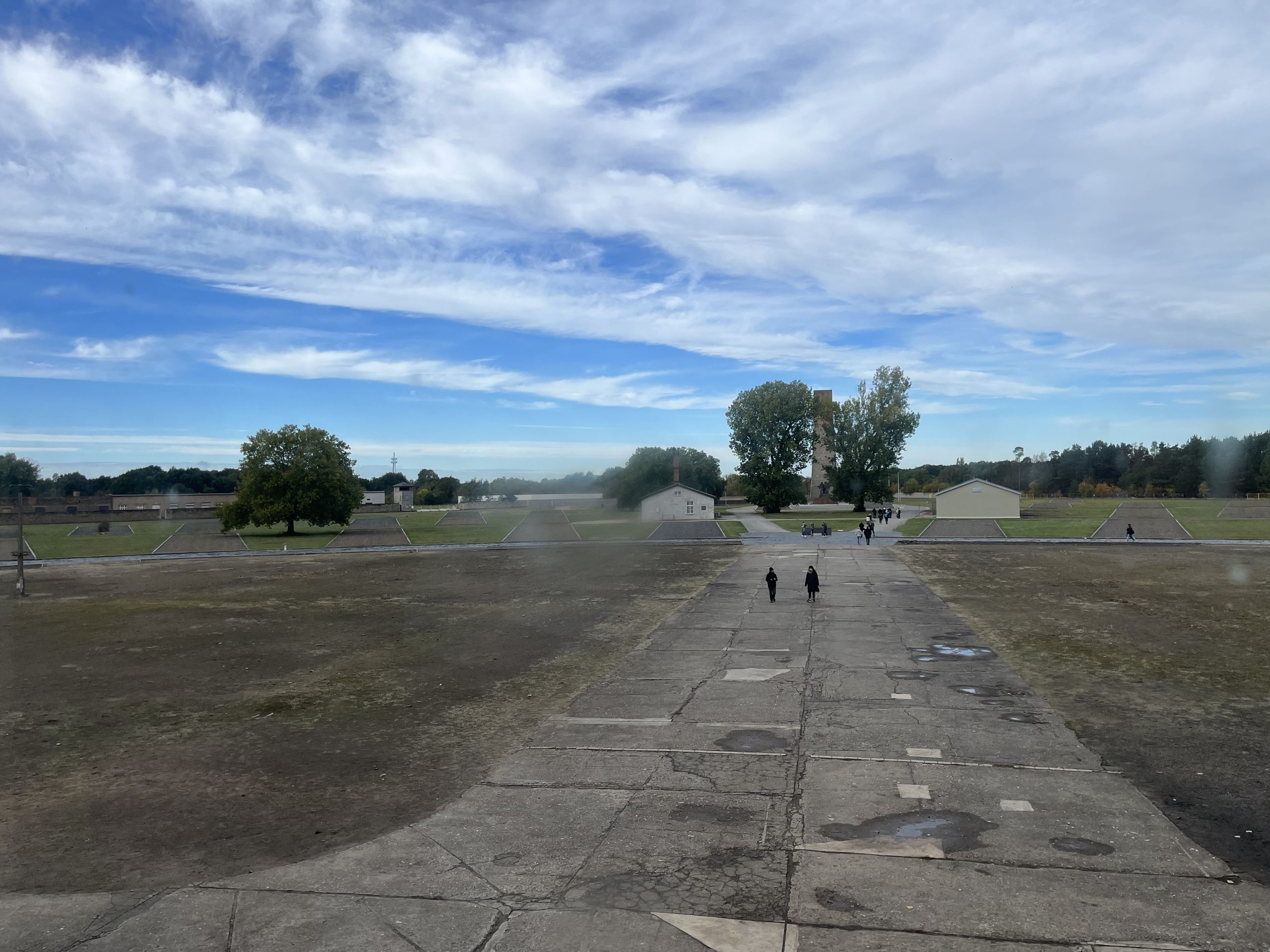
View from the tower
Beneath the tower is a gate with the phrase arbeit macht frei (‘work sets you free’) which is found in many Nazi concentration camps.

The entrance gate to the camp
We learned about the ’neutral zone’, a perimeter area of the camp upon which, if you were found there, you could be shot without warning.

The ‘neutral zone’
Much of the camp was destroyed by the Soviet Union after the fall of Berlin, but the outline of the buildings remain. The buildings that are still standing, or have been reconstructed, serve as museum pieces with various artefacts and narratives on display.
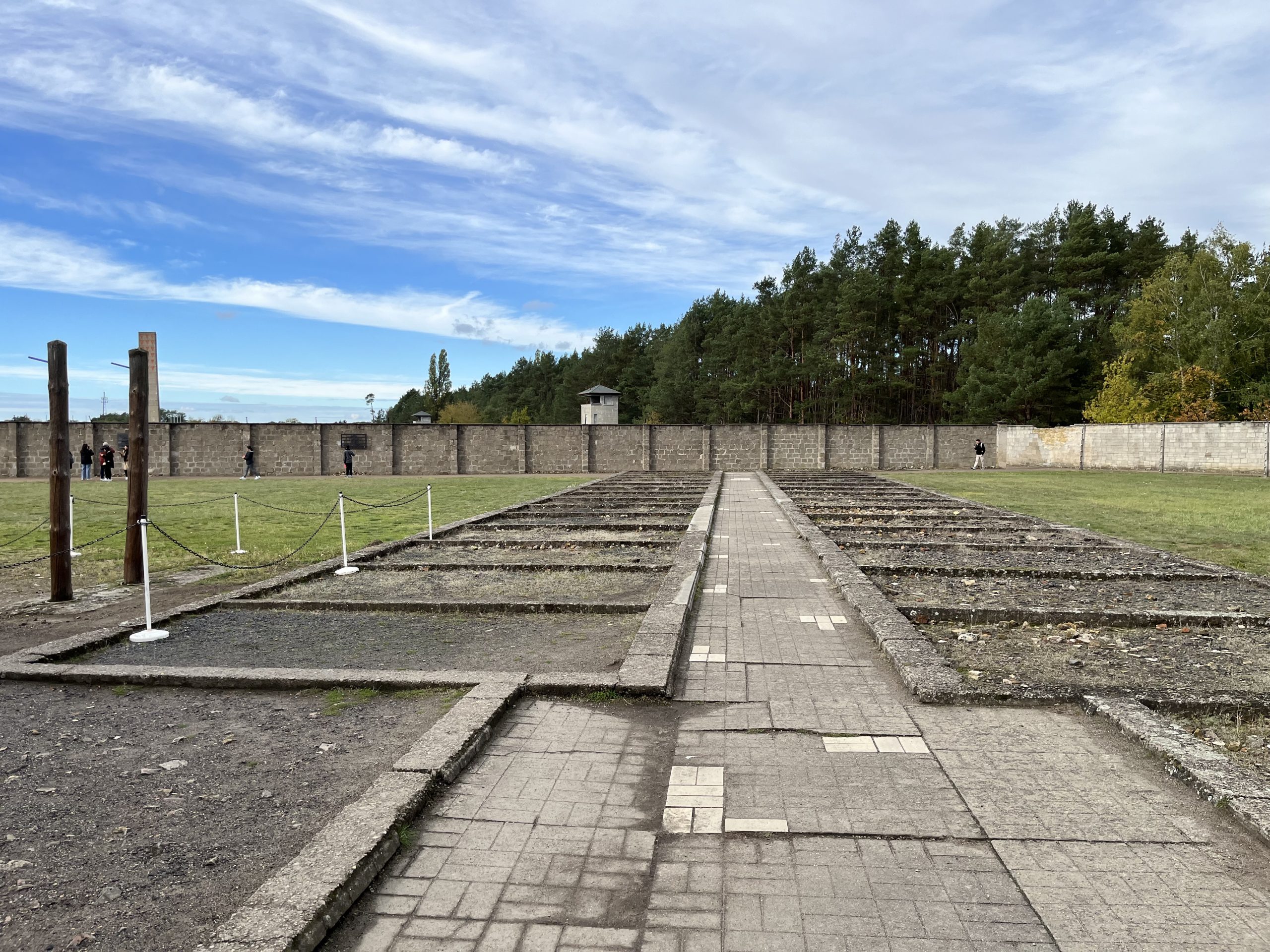
Site of the former prison within the camp — a prison within a prison

Site of one of the barracks
The Soviets repurposed the site, adding a gigantic concrete obelisk and statue in memorial to the victims of the Nazis. The site was used for celebrations of the German Democratic Republic (GDR) during Soviet rule.
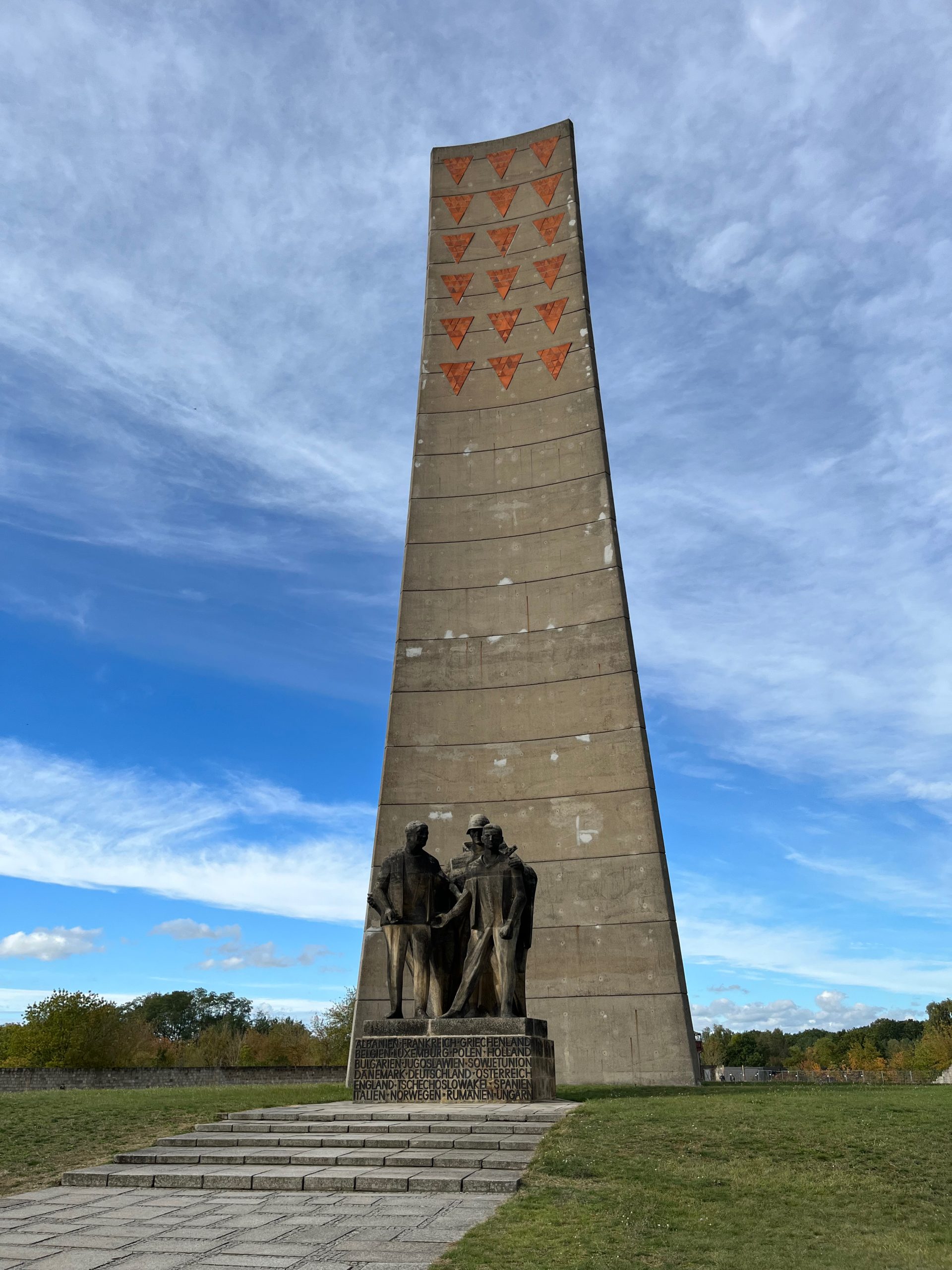
Soviet obelisk and statue inside Sachsenhausen Concentration Camp
Our tour finished with a visit to ‘Station Z’, named as a sick joke by the Nazis as the final place that the prisoners would go to after they began their time at the camp by entering through Tower A. The area consisted of an execution trench as well as the remains of buildings that were used to systematically execute and burn thousands of people. Despite looking at it in person, it was so difficult to comprehend and feel what had happened here. Our guide made the point that without visitors who are willing to see the site, to learn and to remember, it is just a pile of bricks and statues. The act of us taking the time to go there was important.
Our tour lasted six hours. Having a well-informed guide was excellent, but there was still so much that we didn’t see and didn’t read as we were under a little bit of time pressure to get back for our train.
It was a very heavy day. After getting back to the city, we needed some light relief, so we made our way to a riverside bar to talk and unwind.
Berlin is an incredible place. There is modernity, history and complexity at every turn.

Our favourite building, right next to our hotel and the main train station. A beautiful glass cube with restaurants and cafes at the base.
Through the rest of the trip we found ourselves singing in the amusingly bizarre Monster Ronson’s Ichiban Karaoke Bar…
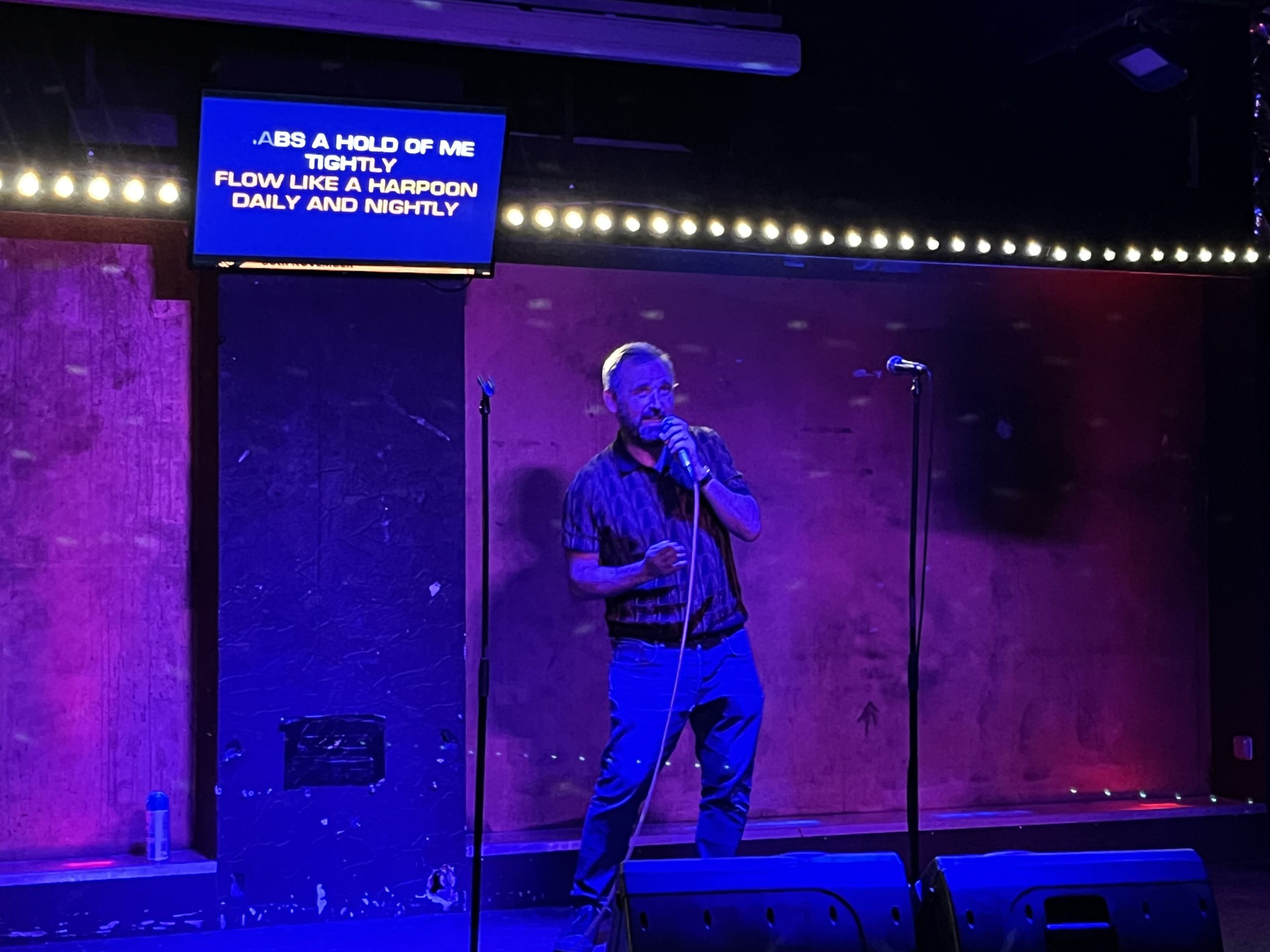
To the extreme…
…gazing out across Berlin from the roof of the Futurium…

On top of the Futurium. The glass dome of the Reichstag building is right behind me.
…spotting the route of where the Berlin Wall used to be…

The site of the Berlin Wall is marked by cobblestones across the city
…and visiting a surviving section of the Wall which had been turned into an open air art gallery.

Section of the Berlin Wall painted with artwork from Pink Floyd’s The Wall
I also enjoyed a 10km run with one of my brothers on the last morning of our trip.
In our four days know that we only scratched the surface of all of the things that the city offers. I’d love to go back.

The Reichstag at sunset
Aside from the trip, this was a week in which I:
- Welcomed my wife back from her own long weekend away with her friends. On Monday I had to delay getting out of the house and into London until after I’d made sure that the boys were well on their way to school.
- Consolidated information and revised the materials for an initiative that we may undertake with a vendor. I’ve got some meetings set up to review them and agree on next steps.
- Continued work with my product development and product management functions to bring them closer together.
- Reviewed the summary of a business case for a software deployment by our infrastructure team.
- Worked on some slides for an IT-department wide initiative.
- Completed a document that presents an overview of my team’s capabilities/services, products and current initiatives.
- Attended Microsoft-led training on their 365 Copilot product.
- Decided to move our ‘clear writing’ training to the start of next year, giving us the time to plan and schedule it properly.
- Attended a webinar from BIE Executive on Challenging the norms to create real inclusion.
- Had a second Virgin Media TV box installed, part of the new contract that they gave me for the same price as the last one.
- Enjoyed a random coffee with a high-profile member of the WB-40 podcast community who had some very unusual challenges ahead of him.
Next week: A trip to Bristol, two days in the office — and catching up with weeknotes, as I’m now a week behind.
Next time go to the Wannsee Conference House…..
A fantastic time spent in Berlin with my boys. I am sure that we will be talking about it for a very long time.
Dad. X